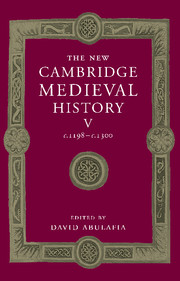Book contents
- Frontmatter
- Introduction
- Part I Common Themes
- 1 Social change in the thirteenth century
- (a) Nobles and knights
- (b) Urban society
- (c) Rural society
- 2 Commerce and communications
- 3 The vernacular
- 4 Art and architecture
- Part II The Church in the Thirteenth Century
- Part III The Western Kingdoms
- Part IV Italy
- Part V The Mediterranean Frontiers
- Part VI The Northern and Eastern Frontiers
- Appendix Genealogical tables
- Primary sources and secondary works arranged by chapter
- Index
- Plate section
- Map 1 Europe in the thirteenth century
- Map 3 France, c. 1260
- Map 5 Germany and the western empire
- Map 6 Genoa, Venice and the Mediterranean
- Map 8 The Latin empire of Constantinople and its neighbours
- Map 10 Aragon and Anjouin the Mediterranean">
- References
(b) - Urban society
from 1 - Social change in the thirteenth century
Published online by Cambridge University Press: 28 March 2008
- Frontmatter
- Introduction
- Part I Common Themes
- 1 Social change in the thirteenth century
- (a) Nobles and knights
- (b) Urban society
- (c) Rural society
- 2 Commerce and communications
- 3 The vernacular
- 4 Art and architecture
- Part II The Church in the Thirteenth Century
- Part III The Western Kingdoms
- Part IV Italy
- Part V The Mediterranean Frontiers
- Part VI The Northern and Eastern Frontiers
- Appendix Genealogical tables
- Primary sources and secondary works arranged by chapter
- Index
- Plate section
- Map 1 Europe in the thirteenth century
- Map 3 France, c. 1260
- Map 5 Germany and the western empire
- Map 6 Genoa, Venice and the Mediterranean
- Map 8 The Latin empire of Constantinople and its neighbours
- Map 10 Aragon and Anjouin the Mediterranean">
- References
Summary
THE line between urban and rural society, the small town and the big village, is a fine one and traditionally depends on whether or not a majority of the population supported itself other than by fishing, farming, mining or tending herds. In the past, there has been a tendency to identify towns solely by their legal status; this is not entirely satisfactory. Some unusual villages contained 1,000 people; a small town might not have much more. Thousands of small market towns existed across Europe and fulfilled the vital local functions of providing a place where people could exchange goods and supplies, repair their farm implements, have their children baptised or attend a fair. At around 5,000 people (in more densely settled regions) a city assumed certain features more characteristic of urban society, but in Scandinavia or eastern Europe even smaller places were impressive in local terms. A symbiotic relationship existed between all cities and their countrysides; any contrast between urban and rural society runs the risk of posing a false dichotomy. Arbitrary chronology is also a problem; the years 1198 and 1300 do not mark any decisive events affecting urban society across Europe.
Europe in the thirteenth century remained an overwhelmingly rural society, and so cities were still distinctive islands in a sea of villages and hamlets. The theme of urban societies must not turn these cities into generic types. Important regional differences must not be obscured, and nor should these places be rendered so typical as to conceal the process of change. On the most basic level, western Europe had more cities than the east, but this century marks the rise of some newly significant places as distant as Moscow. Many of Europe’s largest cities dotted the Mediterranean from Gibraltar to the Bosphorus, but a similar band of newer towns followed the sea coast from the English Channel to the Gulf of Finland.
Keywords
- Type
- Chapter
- Information
- The New Cambridge Medieval History , pp. 26 - 37Publisher: Cambridge University PressPrint publication year: 1999
References
- 5
- Cited by

